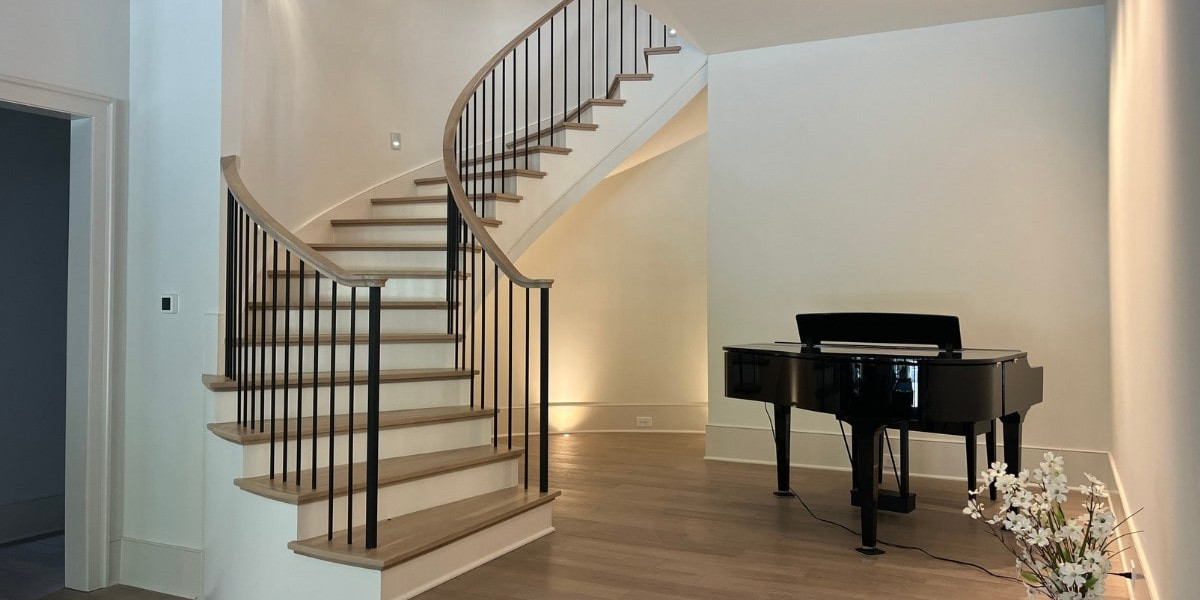The curved staircase design is one of the most elegant architectural features that can transform the look of any home or commercial space. Known for its smooth, flowing lines and timeless appeal, this design adds a sense of luxury and sophistication. Beyond aesthetics, a well-planned curved staircase design offers functional and structural benefits while also serving as a central statement piece in the overall interior layout.
In this article, we will explore the uses, advantages, and disadvantages of a curved staircase design so you can decide if it’s the right choice for your space.
Understanding Curved Staircase Design
A curved staircase design features a continuous arc without any landings between flights. Unlike spiral staircases, which are compact and tight, a curved staircase offers a broader, sweeping curve that creates a grand appearance. These staircases can be customized to fit different architectural styles, from modern minimalism to traditional elegance.
Key characteristics include:
Smooth, sweeping curve instead of sharp angles.
Wide and comfortable steps.
Customizable railing and baluster designs.
Can be centrally placed or aligned along a wall.
Uses of Curved Staircase Design
A curved staircase design is not just a structural element—it’s also a design statement. Here are some common uses:
1. Enhancing Luxury Homes
Luxury residences often use curved staircases as a focal point in grand entryways. The dramatic shape draws attention and creates an inviting flow.
2. Showcasing Architectural Skill
Because of its complexity, this design is often used to highlight craftsmanship and creativity, making it ideal for projects where visual impact matters.
3. Maximizing Space in Certain Layouts
In larger homes or open-plan buildings, a curved staircase can be placed strategically to complement traffic flow without creating harsh lines.
4. Adding Elegance to Commercial Spaces
Hotels, event venues, and upscale restaurants use curved staircase designs to impress guests and elevate the overall ambiance.
Advantages of Curved Staircase Design
Opting for a curved staircase design offers several benefits that go beyond beauty. Here are some major advantages:
1. Aesthetic Appeal
Instantly creates a high-end look.
Offers graceful, fluid lines that blend well with various architectural styles.
Works well with both classic and contemporary interiors.
2. Customization Flexibility
Can be tailored in size, curvature, materials, and finishes.
Suitable for wood, glass, steel, or a combination of materials.
Allows for creative railing patterns and lighting effects.
3. Enhanced Flow and Movement
Curved stairs offer a gentle ascent and descent, making them comfortable to use.
Ideal for spaces that aim for a softer visual transition between floors.
4. Increased Property Value
A well-built curved staircase design can make a property more desirable to buyers and add to its market value.
Disadvantages of Curved Staircase Design
While beautiful and functional, this staircase style does come with a few challenges:
1. Higher Cost
Requires more labor, expertise, and materials than straight or L-shaped staircases.
Custom designs can significantly increase the budget.
2. Complex Construction
Needs experienced craftsmen and precise engineering.
More time-consuming to build compared to simpler designs.
3. Space Requirements
Not ideal for small spaces because it generally needs a broader footprint.
Placement must be carefully planned to avoid obstructing key areas.
4. Maintenance Concerns
Depending on materials, curved railings and steps can be more difficult to clean or repair.
Irregular shapes may require custom parts for replacement.
Best Practices for Choosing a Curved Staircase Design
If you’re considering a curved staircase design, here are some tips to ensure it works perfectly in your space:
Assess Available Space: Ensure the staircase has enough room to curve naturally without crowding.
Select Durable Materials: Choose materials that match your interior style while offering long-lasting strength.
Work with Skilled Professionals: This design requires precision, so hire experienced architects and builders.
Plan Lighting: Accent lighting can highlight the curve and add drama.
Coordinate with Interior Style: Make sure the design complements the rest of your décor.
Popular Material Options for Curved Staircase Design
Your choice of materials can greatly influence the final look and feel of your curved staircase design.
Wood: Warm and traditional, ideal for classic interiors.
Glass: Perfect for modern, airy spaces; pairs well with metal frames.
Steel: Offers a sleek and industrial feel.
Marble or Stone: Adds luxury and durability.
Maintenance Tips for Curved Staircase Design
To keep your curved staircase design looking stunning for years:
Regular Cleaning: Dust railings, treads, and risers to maintain appearance.
Check for Wear: Inspect handrails and steps for any damage.
Polish or Treat Surfaces: Depending on the material, use the appropriate polish or protective coating.
Tighten Fixtures: Ensure all bolts and fasteners remain secure.
Conclusion
A curved staircase design offers unmatched elegance and sophistication for both residential and commercial spaces. It serves as an architectural centerpiece, combining style with function. While it requires more investment in terms of space, cost, and craftsmanship, the result is a breathtaking feature that can elevate any property’s appeal.







